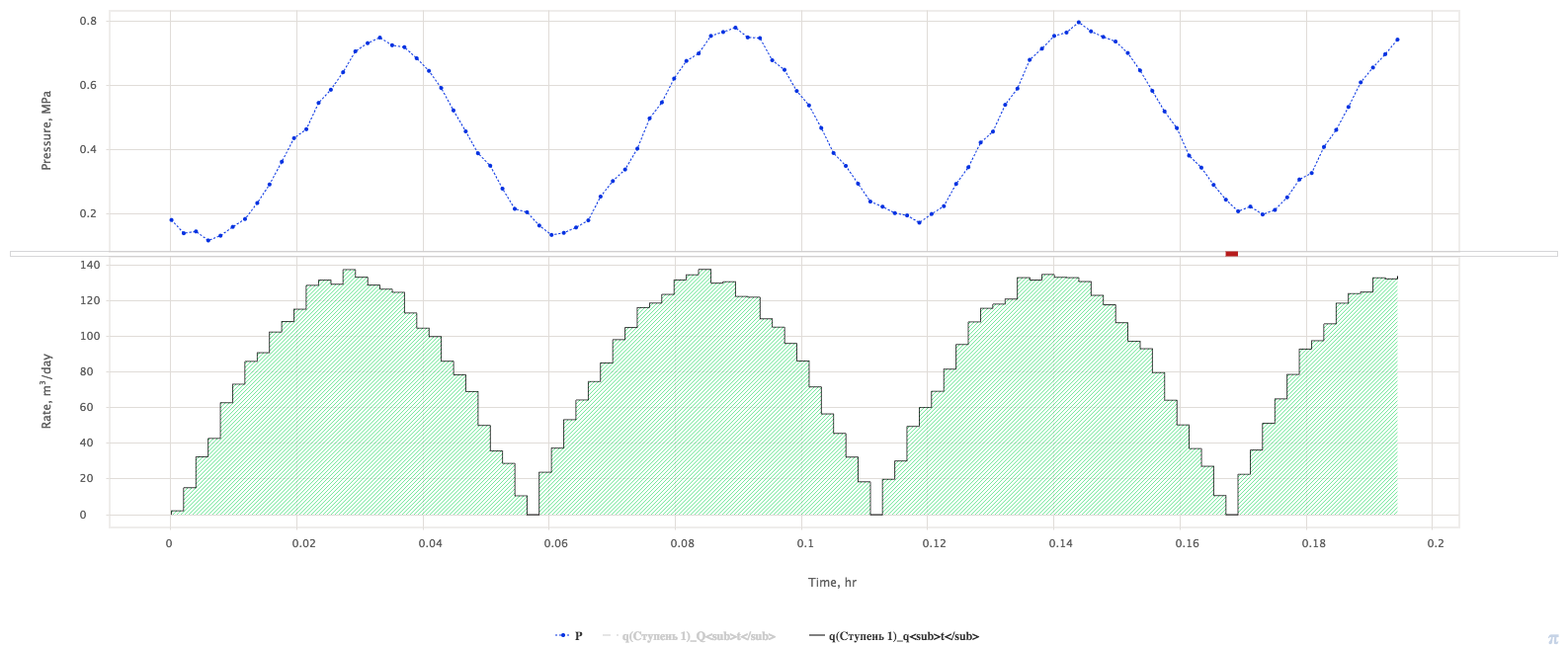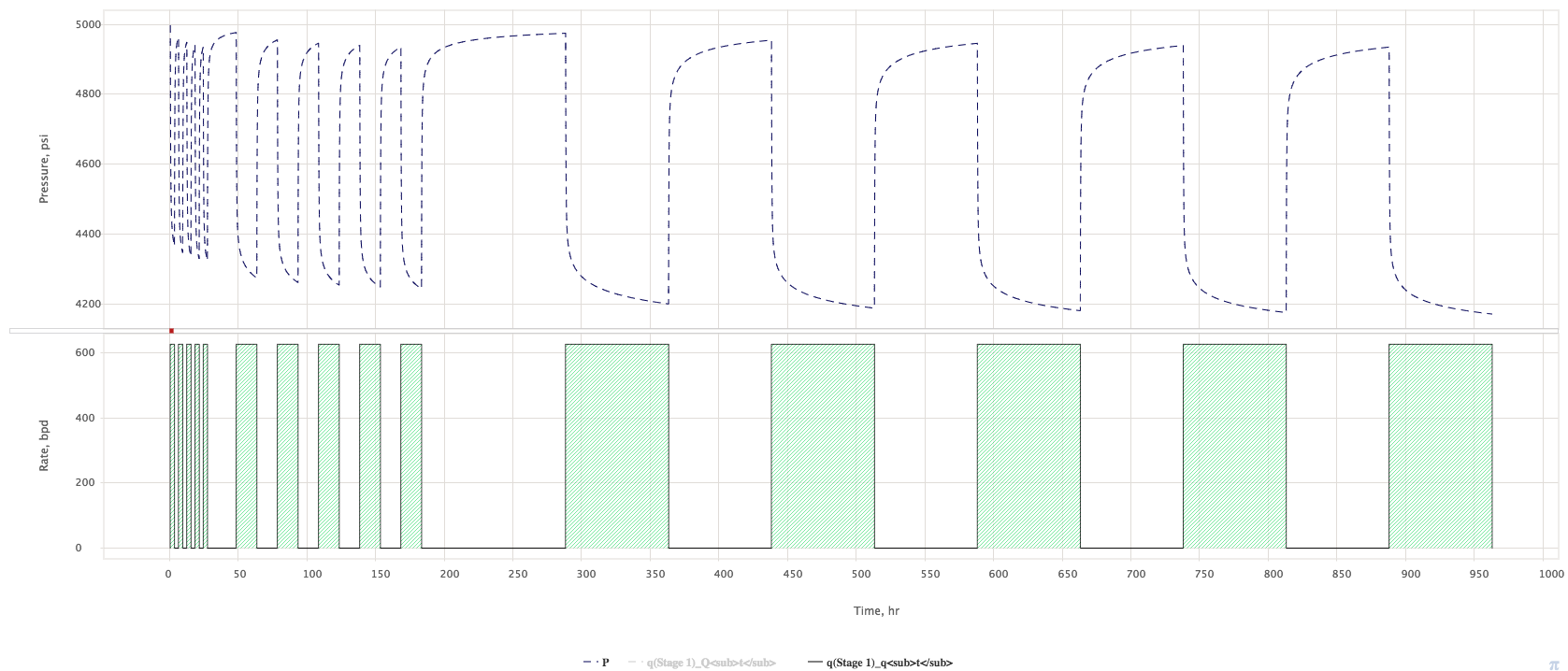1. Motivation
One of the most important objectives of the well testing is to assess the drainable oil reserves and reservoir properties around tested well.
This particularly becomes important in appraisal drilling as well testing is the only source of this information.
The Self-Pulse Test (SPT) is a single-well pressure test with periodic changes in flow rate and pressure (see Fig. 1).
| Fig. 1. Typical record of pressure and rate variation during SPT |
When flow rate is being intentionally varied in harmonic cycles with sandface amplitude q_0 and cycling frequency \omega = \frac{2 \, \pi}{T}:
| (1) | q(t) = q_0 \, \sin ( \omega \, t ) |
then bottom-hole pressure will follow the same variation pattern:
| (2) | p_{wf}(t) = p_0 \, \sin ( \omega \, [ t - t_{\Delta} ] ) |
with a bottom-hole pressure amplitude p_0 and the time delay t_{\Delta}.
It takes some time (3-5 cycles t \geq 3 \, T) for pressure to develop a stabilized response to rate variations.
The pressure delay t_{\Delta} and associated dimensionless phase shift \Delta = \omega \, t_{\Delta} represent the inertia effects from the adjoined reservoir and characterized by formation pressure diffusivity:
| (3) | \chi = \Big < \frac{k}{\mu} \Big > \frac{1}{\phi \, c_t} |
The diffusion nature of pressure dictates that amplitude of pressure variation is proportional to amplitude of sandface flowerate variation and the ratio \frac{p_0}{q_0} is related to formation transmissibility:
| (4) | \sigma = \Big < \frac{k}{\mu} \Big > \, h |
The exact solution of differential diffusion equation for vertical well with negligible well storage and infinite boundary homogeneous reservoir can be represented by a system of non-linear algebraic equations, relating field-measured parameters \big\{ \frac{q_0}{p_0}, \, t_{\Delta} \big\} to formation properties \{ \sigma, \, \chi \}:
| (5) | X =r_w \, \sqrt{ \frac{\omega}{\chi} } |
| (6) | \Delta = \omega \, t_{\Delta} = \frac{\pi}{4} - arctg{ \frac{Ker_1 X \cdot Kei \, X - Ker_1 X \cdot Kei \, X }{Ker_1 X \cdot Kei \, X +Ker_1 X \cdot Kei \, X } } |
| (7) | \sigma =\frac{1}{2 \pi} \, \frac{q_0}{p_0} \, \sqrt{ \frac{Ker^2 X + Kei^2 X}{Ker_1^2 X + Kei_1^2 X} } |
The above equations assume that diffusivity \chi and dimensionless radius X are found from (5) – (6) and then X is substituted to (7) to calculate transmissibility \sigma.
In case of a low frequency pulsations:
| (8) | \omega \ll 0.00225 \, \frac{ \chi }{ r_w^2} \quad \Longleftrightarrow \quad X \ll 0.15 |
the equations (5) – (7) can be explicitly resolved in terms of transmissibility and diffusivity:
| (9) | \chi = 0.25 \, \omega \, \gamma^2 \, r_w^2 \, \exp \frac{\pi}{2 \, {\rm tg} \Delta } |
| (10) | \sigma = \frac{q_0}{8 \, p_0 \, \sin \Delta} |
where \Delta = \omega \, t_{\Delta}.
2. Objectives
- Assess reservoir volume around well
- Assess reservoir permeability and thickness variation around well
3. Deliverables
The advantages of SPT deliverables over conventional single-well test is illustrated below.
| Vhc | Potential hydrocarbon reserves |
| Ve | Drainage volume |
| Ae | Drainage area |
| knear | Permeability of the near-reservoir zone |
| hnear | Effective thickness of the near-reservoir zone |
| kfar | Permeability of the far-reservoir zone |
| hfar | Effective thickness of the far-reservoir zone |
| S | Skin-factor |
| Pu(t) | Deconvolution of the long-term unit-rate response |
BUS – Build-up Survey
Conventional single-well testing is based on long-term monitoring of downhole pressure response to the step change in flow rate (usually shut-in or close-in).
The primary hard data deliverables are:
- formation pressure
P_i
- skin-factor S
- average transmissibility in drainage area
\sigma
- time to reach the reservoir boundary t_e
The conditional deliverables from build-up survey would be:
| Deliverables | Description | Non-BUS Input Parameters | Key Uncertainties | ||||||
|---|---|---|---|---|---|---|---|---|---|
where c_t is total compressibility:
and \{ c_r, \, c_o \, c_w \} are rock, oil and water compressibility. | Drainable oil reserves | The rock compressibility
c_r(\phi) is defined from core lab study or empirical porosity correlations Fluid compressibility
\{ c_o , \, c_w \} from PVT Initial water saturation s_{wi} from SCAL |
Initial water saturation
s_{wi} | ||||||
where \chi is pressure diffusivity:
where \phi is reservoir porosity, \big< \frac{k}{\mu} \big> is fluid mobility:
k_a is absolute permeability to air, k_{rw}, \, k_{ro} are relative permeabilities to water and oil,
\mu_w, \mu_o are water and oil viscosities | Drainage area | Formation porosity
\phi Absolute permeability to air k_a from core study
Fluid viscosities \{ \mu_w, \mu_o \} from PVT | Absolute permeability to air k_a | ||||||
| Effective reservoir thickness | Absolute permeability to air k_a from core study
Fluid viscosities \{ \mu_w, \mu_o \} from PVT | Absolute permeability to air k_a
|
As one can see, the drainage area and the reservoir thickness are conditioned by core data which may not be representative of the whole drainage area.
SPT – Self-Pulse Testing
The single-well self-pulse test is based on long-term monitoring of downhole pressure response to the periodic rate step change (usually shut-in or close-in).
If flowrate
The primary hard data deliverables are:
- formation pressure
P_i
- skin-factor S
- near
\sigma_{near} and far
\sigma_{far} zone transmissibility
- near
\chi_{near} and far
\chi_{far} zone pressure diffusivity
- time to reach the reservoir boundary t_e
The SPT is correlating pressure variation with pre-designed flowrate variation sequence and tracks:
- pressure response amplitude which depends on formation transmissibility \sigma
and
- time lag between flowrate variation and pressure response which depends on formation diffusivity \chi.
This allows estimating effective formation thickness
h directly from field survey without assumptions on core-based permeability (compare with
(21)) and consequently leads to assessing the drainange area
A_e, fluid mobility
\bigg< \frac{k}{\mu} \bigg> and absolute permeability
k_a with lesser uncertainties than in BUS:
| Deliverables | Description | Non-BUS Input Parameters | Key Uncertainties | ||
|---|---|---|---|---|---|
| Effective reservoir thickness | Formation porosity
\phi Rock compressibility
c_r(\phi) Initial water saturation
s_{wi} Fluid compressibility
\{ c_o , \, c_w \} | Rock compressibility c_r(\phi) | ||
| Drainage area | Rock compressibility
c_r(\phi) Initial water saturation
s_{wi} Fluid compressibility
\{ c_o , \, c_w \} | Rock compressibility c_r(\phi) | ||
| Fluid mobility | Rock compressibility c_r(\phi) Initial water saturation
s_{wi} | Rock compressibility c_r(\phi) Initial water saturation s_{wi} | ||
| Absolute permeability | Rock compressibility c_r(\phi) Initial water saturation s_{wi} Relative permeabilities
\{ k_{rw}, \, k_{ro} \} Fluid viscosities
\{ \mu_w, \mu_o \} | Rock compressibility c_r(\phi) Initial water saturation s_{wi} Relative permeabilities \{ k_{rw}, \, k_{ro} \} |
The absoluite permeability from SPT k_a |_{SPT} is usually stacked up against core-based permeability k_a |_{CORE} to validate the core samples and assess the effects of macroscopic features which are overlooked at core-plug size level.
Running SPT in two different cycling frequences allows assessing the near and far resevroir zones spearately.
The usual SPT workflow includes several cycling tests with different frequencies, the lower the frequency the longer the scanning range.
This captures variation of permeability and thickness when moving away from well location.
Together with deconvolution, the SPT is reproducing conventional PTA information and providing additional data on pressure diuffusivity.
This maybe used as estimation of permeability and thickness separately and their variation away from well location.
4. Inputs
| Property | Description | Data Source |
|---|---|---|
| Bo | Oil Formation Volume Factor | PVT samples / Correlations |
| Bg | Gas Formation Volume Factor | PVT samples / Correlations |
| Bw | Water Formation Volume Factor | PVT samples / Correlations |
| co | Oil compressibility | PVT samples / Correlations |
| cw | Water compressibility | PVT samples / Correlations |
| cg | Gas compressibility | PVT samples / Correlations |
| cr | Rock compressibility | Core samples / Correlations |
| swi | Initial water saturation | Core samples |
\phi | Porosity | Core samples |
5. Procedure
The typical SPT procedure is brought on Fig. 2.
| Fig. 2. Typical SPT procedure |
It normally consists ion three consequent tests with three different cycling frequencies:
- Test 1 = high freq pulsations (10 pulses with period T)
- Test 2 = mid freq pulsations (10 pulses with with period 5T)
- Test 3 = Low freq pulsations (10 pulses with period 25 T)
The total duration of the test is 310 T.
Typically T = 3 hrs and total test duration is around 40 days.
Every pulse includes one choke-up and one choke-down so that full SPT survey require 60 choke operations during 40 days which is a lot of field activity for a given well.
It would be extremely difficult to perform this manually and usual practice is to arrange a programmable remote-controlled flow variation.
6. Interpretation
- Numerical model
- Single well with circle boundary
- High density LGR
- High density time grid (seconds)
- Single well with circle boundary
- Automated pressure match in simulation software

